Christian V – God’s Anointed Warrior
24 April until 24 October
Christian V (1646–1699) was the first king in Danish history to inherit the throne directly, without first being elected. The absolute monarchy had been introduced just 10 years earlier, and Christian V was the first absolute monarch to be anointed in Frederiksborg Castle Chapel in 1671. Now, only God was above the king. As laid out in the new Danish constitution of 1665, the king was no longer compelled to listen to the requests of the nobility.
Christian V, who took to the throne at the age of 24 years, was neither academically gifted nor politically savvy like his father, Frederik III. However, he was diligent, conscientious and courageous. He was also an avid hunter and horseman and, unlike his father, he had the common touch, which earned him the affection of his subjects.
The exhibition ‘Christian V – God’s Anointed Warrior’ draws a picture of an unusual king, whose main strength was his physical prowess. In a manner novel for a king, he used his physique and his ability as a horseman, hunter and soldier to fill his role as national leader.
The Royal Danish Collection contains many impressive artefacts and garments associated with the life of Christian V. Because many of the exhibits are quite fragile and sensitive to light, they are not normally accessible to the public.
In the exhibition you can see Christian V’s anointment robe, which has only been used for royal anointments and in castrum doloris ceremonies (where the majesty’s coffin is placed on public display). It will not be used again until the time of HM the Queen’s funeral. Also on display are Christian V’s lavish warrior’s outfits, weapons and decorative objects as well as a wide selection of portraits of the King. You can also see the antlers of the stag whose fall allegedly caused the King’s death.
Every weekend: we bring the royal court to life
Every weekend until 24 October as well as on special occasions, you will have the opportunity to meet members of Christian V’s royal household in and outside the exhibition.
Among others, you may meet the divinely ordained king Christian V himself, Chancellor Peder Griffenfeld and Queen Charlotte Amalie. They all have lots of stories to tell, but no one is more knowledgeable about affairs at the court than the Queen’s own lady-in-waiting. She knows everything that goes on in the royal chambers, and if you’ll lend her an ear, she is happy to share everything she knows – and a little more.
See a selection of the exhibits below.
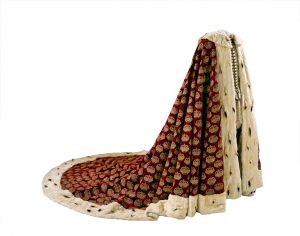
Photo: © Royal Danish Collection.
Christian V’s anointment robe. The robe has 1,400 embroidered gold crowns and is lined with ermine. The robe, which has only been used for royal anointments and in castrum doloris ceremonies (where the majesty’s coffin is placed on public display), will not be used again until the time of HM the Queen’s funeral.
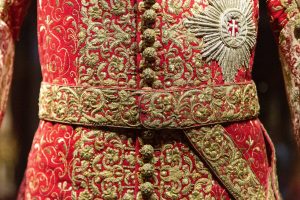
Photo: Berit Møller © Royal Danish Collection.
Christian V’s carousel outfit. A carousel was a special form of jousting tournament that was as much about showing off extravagant costumes and weapons as it was about good horsemanship. This carousel outfit is embroidered all over with gold thread and lined with embroidered silk. It has wide, knee-long skirts that drape beautifully over the saddle.
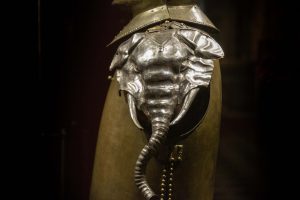
Photo: Berit Møller © Royal Danish Collection.
Christian V’s elephant armour. Jousting armour from 1680, with elephants on the shoulders and helmet. In the second half of the 17th century, elephants were used as a symbol of the Danish king. This special armour was used for a knight’s carousel in celebration of the wedding of Ulrikke Eleonore (1656–1693), Christian V’s sister, the Queen of Sweden.
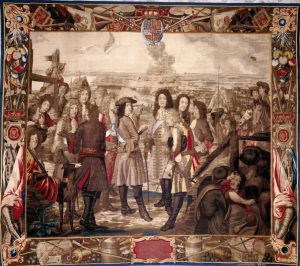
Photo: © Royal Danish Collection.
The Rosenborg Tapestries. The capture of Landskrona’s citadel on 4 August 1676.
The tapestries depict scenes from the Scanian War (1685–93) with Christian V leading the charge. The goal of the war was to recapture the areas east of the Øresund strait that Denmark had given up in the Treaty of Roskilde in 1658. The tapestries, which were commissioned by Christian V, show Sweden being dealt a crushing defeat. The truth is a different story – in fact, Sweden won a resounding victory.
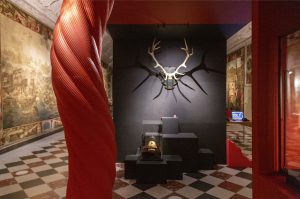
Photo: Berit Møller © Royal Danish Collection.
Antlers from a wounded stag that Christian V put of its misery in 1698. When the animal fell, its weight knocked over the King, who was injured in the fall.
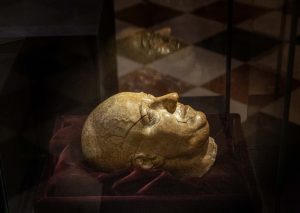
Photo: Berit Møller © Royal Danish Collection.
Death mask of Christian V. The death mask is based on a plaster cast taken from the face of the king shortly after his death. This mould is then used to make a positive cast to reproduce a perfect likeness of the late king’s face. Jim Lyngvild’s bust of Christian V in the portrait gallery is based on this mask.
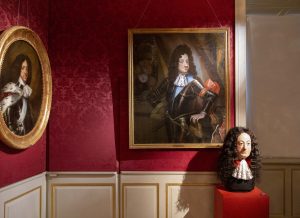
Photo: Berit Møller © Kongernes Samling.
Bust of Christian V created by Jim Lyngvild. To achieve the best possible likeness, Lyngvild based the bust on the King’s death mask as well as the study of numerous artistic portrayals of the King.
 Dansk
Dansk
 English
English
 Deutsch
Deutsch
